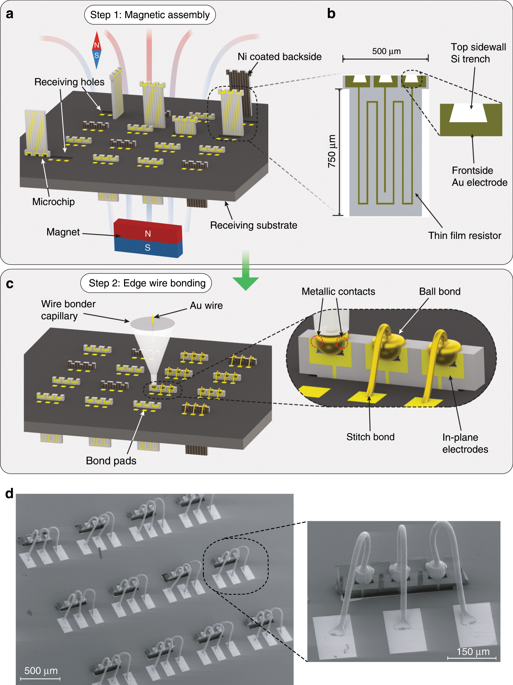Microsystems & Nanoengineering ( IF 7.3 ) Pub Date : 2020-02-24 , DOI: 10.1038/s41378-019-0126-6 Federico Ribet 1 , Xiaojing Wang 1 , Miku Laakso 1 , Simone Pagliano 1 , Frank Niklaus 1 , Niclas Roxhed 1 , Göran Stemme 1

|
The out-of-plane integration of microfabricated planar microchips into functional three-dimensional (3D) devices is a challenge in various emerging MEMS applications such as advanced biosensors and flow sensors. However, no conventional approach currently provides a versatile solution to vertically assemble sensitive or fragile microchips into a separate receiving substrate and to create electrical connections. In this study, we present a method to realize vertical magnetic-field-assisted assembly of discrete silicon microchips into a target receiving substrate and subsequent electrical contacting of the microchips by edge wire bonding, to create interconnections between the receiving substrate and the vertically oriented microchips. Vertical assembly is achieved by combining carefully designed microchip geometries for shape matching and striped patterns of the ferromagnetic material (nickel) on the backside of the microchips, enabling controlled vertical lifting directionality independently of the microchip’s aspect ratio. To form electrical connections between the receiving substrate and a vertically assembled microchip, featuring standard metallic contact electrodes only on its frontside, an edge wire bonding process was developed to realize ball bonds on the top sidewall of the vertically placed microchip. The top sidewall features silicon trenches in correspondence to the frontside electrodes, which induce deformation of the free air balls and result in both mechanical ball bond fixation and around-the-edge metallic connections. The edge wire bonds are realized at room temperature and show minimal contact resistance (<0.2 Ω) and excellent mechanical robustness (>168 mN in pull tests). In our approach, the microchips and the receiving substrate are independently manufactured using standard silicon micromachining processes and materials, with a subsequent heterogeneous integration of the components. Thus, this integration technology potentially enables emerging MEMS applications that require 3D out-of-plane assembly of microchips.
中文翻译:

通过磁性组装和边缘引线键合垂直集成微芯片
在各种新兴的 MEMS 应用(例如高级生物传感器和流量传感器)中,将微制造平面微芯片平面外集成到功能性 3D (3D) 设备中是一个挑战。然而,目前没有传统方法提供一种通用的解决方案来将敏感或易碎的微芯片垂直组装到单独的接收基板中并建立电连接。在这项研究中,我们提出了一种方法来实现将离散硅微芯片垂直磁场辅助组装到目标接收基板中,然后通过边缘引线键合实现微芯片的电接触,以在接收基板和垂直取向的微芯片之间建立互连. 垂直组装是通过结合精心设计的微芯片几何形状来实现的,用于形状匹配和微芯片背面的铁磁材料(镍)的条纹图案,实现独立于微芯片纵横比的受控垂直提升方向。为了在接收基板和垂直组装的微芯片之间形成电连接,仅在其正面具有标准金属接触电极,我们开发了边缘引线键合工艺,以在垂直放置的微芯片的顶部侧壁上实现球形键合。顶部侧壁具有与正面电极相对应的硅沟槽,这会引起自由空气球的变形,并导致机械球焊固定和边缘金属连接。边缘引线键合是在室温下实现的,并且显示出最小的接触电阻 (<0.2 Ω) 和出色的机械强度(在拉力测试中 >168 mN)。在我们的方法中,微芯片和接收基板使用标准的硅微加工工艺和材料独立制造,随后对组件进行异质集成。因此,这种集成技术有可能实现需要微芯片 3D 平面外组装的新兴 MEMS 应用。











































 京公网安备 11010802027423号
京公网安备 11010802027423号